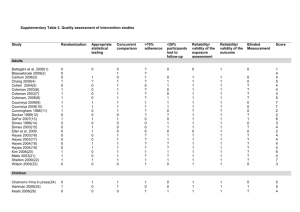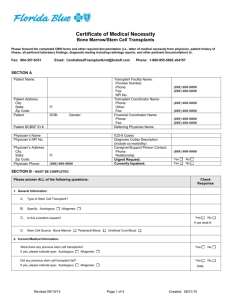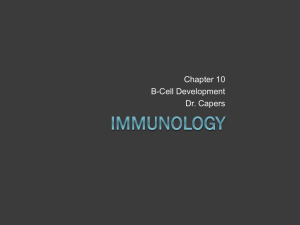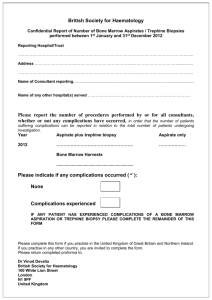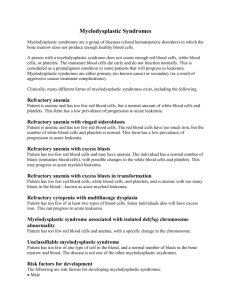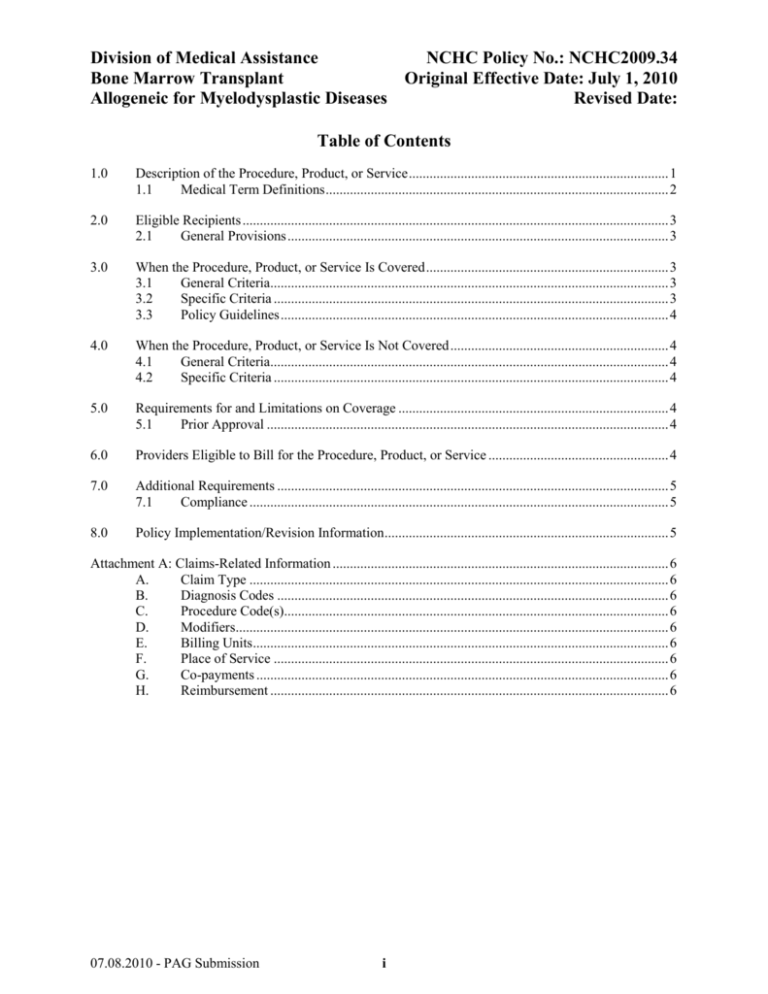
Division of Medical Assistance
NCHC Policy No.: NCHC2009.34
Bone Marrow Transplant
Original Effective Date: July 1, 2010
Allogeneic for Myelodysplastic Diseases
Revised Date:
Table of Contents
1.0
Description of the Procedure, Product, or Service ........................................................................... 1
1.1
Medical Term Definitions ................................................................................................... 2
2.0
Eligible Recipients ........................................................................................................................... 3
2.1
General Provisions .............................................................................................................. 3
3.0
When the Procedure, Product, or Service Is Covered ...................................................................... 3
3.1
General Criteria................................................................................................................... 3
3.2
Specific Criteria .................................................................................................................. 3
3.3
Policy Guidelines ................................................................................................................ 4
4.0
When the Procedure, Product, or Service Is Not Covered ............................................................... 4
4.1
General Criteria................................................................................................................... 4
4.2
Specific Criteria .................................................................................................................. 4
5.0
Requirements for and Limitations on Coverage .............................................................................. 4
5.1
Prior Approval .................................................................................................................... 4
6.0
Providers Eligible to Bill for the Procedure, Product, or Service .................................................... 4
7.0
Additional Requirements ................................................................................................................. 5
7.1
Compliance ......................................................................................................................... 5
8.0
Policy Implementation/Revision Information .................................................................................. 5
Attachment A: Claims-Related Information ................................................................................................. 6
A.
Claim Type ......................................................................................................................... 6
B.
Diagnosis Codes ................................................................................................................. 6
C.
Procedure Code(s)............................................................................................................... 6
D.
Modifiers............................................................................................................................. 6
E.
Billing Units........................................................................................................................ 6
F.
Place of Service .................................................................................................................. 6
G.
Co-payments ....................................................................................................................... 6
H.
Reimbursement ................................................................................................................... 6
07.08.2010 - PAG Submission
i
Division of Medical Assistance
NCHC Policy No.: NCHC2009.34
Bone Marrow Transplant
Original Effective Date: July 1, 2010
Allogeneic for Myelodysplastic Diseases
Revised Date:
1.0
Description of the Procedure, Product, or Service
This policy addresses high-dose chemotherapy and allogeneic stem cell support for
myelodysplastic diseases and myeloproliferative disorders. Bone marrow transplants typically
include high-dose chemotherapy (HDC).
High dose chemotherapy (HDC) involves the administration of cytotoxic agents using doses
several times greater than the standard therapeutic dose. Whole body radiotherapy may also be
given and included in the term HDC when applicable. The most significant side effect of HDC
(also known as myeloablation) is the destruction of the bone marrow and is managed by
reinfusion of allogeneic stem cells in order to repopulate the bone marrow.
In some incidences, non-myeloablative treatment protocols are used in conjunction with infusions
of allogeneic stem cells. Non-myeloablative regimens do not destroy all of the bone marrow
before the transplant is given using the stem cells of a donor. These transplants are also called
"mini-transplants" or "transplantlite."
Allogeneic bone marrow transplantation involves harvesting bone marrow or stem cells from a
healthy donor (related or unrelated to the recipient) for infusion into a recipient whose bone
marrow is compromised. This procedure is an established treatment for certain marrow dysplasias
and aplasias and inborn errors of metabolism.
There are three potential sources of allogeneic stem cells.
a. Bone marrow cells: Bone marrow stem cells can be harvested from a related or unrelated
donor. 2
b. Peripheral stem cells: Stem cells may be harvested from the peripheral blood circulation. This
may involve several pheresis procedures. Pheresis involves withdrawing blood from a donor
in which a portion containing stem cells is separated and retained with the remainder
retransfused back to the donor.
c. Umbilical cord blood: Blood harvested from the umbilical cord and placenta shortly after the
delivery of neonates contains stem cells. Although cord blood is an allogeneic source, these
stem cells are associated with a lower incidence of rejection or graft versus host disease.
Immunologic compatibility between donor and patient is a critical factor for achieving a good
outcome of allogeneic bone marrow transplantation. Compatibility is established by serologic
tissue typing of human leukocyte antigens (HLA) using cellular, serologic, or molecular
techniques. HLA refers to the tissue type expressed at the HLA, A, B, and DR loci on each leg of
chromosome 6. Depending upon the disease being treated, an acceptable donor will match the
recipient at all six HLA antigens or most HLA loci.
Myelodysplastic Syndrome (MDS) refers to a group of related bone marrow disorders
characterized by impaired maturation of hematopoietic cells and a tendency to transform into
acute myelocytic leukemia (AML). The most widely accepted classification system for MDS is
the French-American-British (FAB) system that identifies five (5) types of MDS with increasing
numbers of circulating blast cells as follows:
CPT codes, descriptors, and other data only are copyright 2010 American Medical Association. All
rights reserved. Applicable FARS/DFARS apply.
07.08.2010 - PAG Submission
1
Division of Medical Assistance
Bone Marrow Transplant
Allogeneic for Myelodysplastic Diseases
NCHC Policy No. NCHC2009.34
Original Effective Date: July 1, 2010
Revised Date:
a. Refractory anemia (RA) - fewer than 5% blasts
b. Refractory anemia with ringed sideroblasts (RARS) - fewer than 5% blasts plus more than
15% ringed sideroblasts
c. Refractory anemia with excess blasts (RAEB) - 5% to 20% marrow blasts
d. Refractory anemia with excess blasts in transformation (RAEBT) - 20% - 30% marrow blasts
e. Chronic myelomonocytic leukemia (CMML) - 1% to 20% blasts and often has characteristics
of a myeloproliferative disorder.
Recipients with higher blast counts or complex cytogenetic abnormalities have a greater
likelihood of progressing to AML than do other recipients.
Myeloproliferative Disorders are characterized by the slow but relentless expansion of blood
producing cells with the potential evolution into a blast crisis similar to AML. Myeloproliferative
disorders include the following:
a. Polycythemia vera (PV)
b. Essential thrombocythemia (ET)
c. Primary myelofibrosis also known as agnogenic myeloid metaplasia with myelofibrosis.
Note: Non-myeloablative chemotherapy followed by allogeneic stem cell support may be
referred to as a mini transplant.
1.1
Medical Term Definitions
a. Allogeneic: genetically dissimilar - involves a donor and a recipient; genes are not
identical in each organism.
b. Aplasia: a lack of development of an organ or tissue or of the cellular products from
an organ or tissue.
c. Dysplasia: abnormality of development, in pathology, an alteration in size, shape and
organization of adult cells.
d. Harvesting: to remove tissues or cells from a donor and preserve for transplantation.
e. Hematopoietic: pertaining to or effecting the formation of blood cells.
f.
Immunologic: pertains to antigens, the immune process and how humans and higher
animals fight off disease.
g. Infuse: the therapeutic introduction of a fluid other than blood into a vein (example:
saline solution with a drug added).
h. Malignant: cancerous, not benign; describes a tumor that invades and destroys the
tissues in which it originates and can spread to other sites in the body via the
bloodstream and lymphatic system. If untreated, these tumors cause progressive
deterioration and death.
i.
Metabolism: sum total of all the chemical reactions occurring in body cells; reaction
that transform substances into energy or materials the body can use by means of
anabolism or catabolism.
07.08.2010 - PAG Submission
2
Division of Medical Assistance
Bone Marrow Transplant
Allogeneic for Myelodysplastic Diseases
j.
NCHC Policy No. NCHC2009.34
Original Effective Date: July 1, 2010
Revised Date:
Placenta: Temporary organ formed from both fetal and maternal tissues that provides
nutrients and oxygen to the developing fetus, carries away fetal metabolic wastes,
and produces the hormones of pregnancy.
k. Stem cells: immature generic blood cells that will mature into the various types of
blood cells in the body.
l.
2.0
Umbilical cord: a flexible structure through which the umbilical arteries and vein
pass and which connects the fetus to the placenta.
Eligible Recipients
2.1
General Provisions
To be eligible, NCHC recipients must be enrolled on the date of service.
3.0
When the Procedure, Product, or Service Is Covered
3.1
General Criteria
NCHC covers procedures, products, and services related to this policy when they are
medically necessary and
a.
the procedure, product, or service is individualized, specific, and consistent with
symptoms or confirmed diagnosis of the illness or injury under treatment, and not
in excess of the recipient’s needs;
b.
the procedure, product, or service can be safely furnished, and no equally effective
and more conservative or less costly treatment is available; AND
c.
the procedure, product, or service is furnished in a manner not primarily intended
for the convenience of the recipient, the recipient’s caretaker, or the provider.
3.2
Specific Criteria
a. HDC with HLA matched allogeneic stem cell support may be considered medically
necessary as a treatment of myelodysplastic syndromes based on the following:
1. the recipient has been evaluated and assigned a diagnostic category using the
International Prognostic Scoring System (IPSS) for myelodysplastic syndromes;
AND
2. the treatment meets the National Comprehensive Cancer Network (NCCN)
practice guidelines. Guidelines are available at http://www.nccn.com/TreatmentSummaries.aspx (refer to Myelodysplastic Syndromes).
b. HDC with allogeneic stem cell support may be considered medically necessary as a
treatment of myeloproliferative disorders in the following circumstances:
1. when myeloproliferative disease is associated with progression to myelofibrosis;
2. when there is an evolution of the disease towards acute leukemia; OR
3. when the disease is complicated by essential thrombocythemia with an associated
thrombotic or hemorrhagic disorder.
07.08.2010 - PAG Submission
3
Division of Medical Assistance
Bone Marrow Transplant
Allogeneic for Myelodysplastic Diseases
3.3
NCHC Policy No. NCHC2009.34
Original Effective Date: July 1, 2010
Revised Date:
Policy Guidelines
a. HDC and allogeneic stem cell support should be administered through a clinical trial
whenever possible.
b. HDC with stem cell support is typically considered in those recipients with
increasing numbers of blasts, signaling a possible transformation to acute myeloid
leukemia. Subtypes falling into this category include refractory anemia with excess
blasts, refractory anemia with excess blasts in transformation, or chronic
myelomonocytic leukemia.
c. Recipients with refractory anemia with or without ringed sideroblasts may be
considered candidates for high dose chemotherapy when chromosomal abnormalities
are present or the disorder is associated with the development of significant
cytopenias (e.g., neutrophils less 500/mm3, platelets less than 20,000/mm3).
d. Clinical records should indicate the IPSS Risk category, the biological or
chronological age, Performance Status (ECOG 0,1,2), and the recipient has adequate
clinical status to undergo AML induction.
4.0
When the Procedure, Product, or Service Is Not Covered
4.1
General Criteria
Procedures, products, and services related to this policy are not covered when
a.
the recipient does not meet the eligibility requirements listed in Section 2.0;
b.
the recipient does not meet the medical necessity criteria listed in Section 3.0;
c.
the procedure, product, or service unnecessarily duplicates another provider’s
procedure, product, or service; or
d.
the procedure, product, or service is experimental or investigational.
4.2
Specific Criteria
Allogeneic bone marrow transplant for myelodysplastic diseases is not covered for
myelodysplastic or myeloproliferative disorders other than those listed in Subsection 3.2.
5.0
Requirements for and Limitations on Coverage
5.1
Prior Approval
Prior Approval is required for bone marrow transplant allogeneic for myelodysplastic
diseases.
6.0
Providers Eligible to Bill for the Procedure, Product, or Service
To be eligible to bill for procedures, products, and services related to this policy, providers shall
a. meet NCHC qualifications for participation;
b. be currently enrolled with NCHC; AND
07.08.2010 - PAG Submission
4
Division of Medical Assistance
Bone Marrow Transplant
Allogeneic for Myelodysplastic Diseases
NCHC Policy No. NCHC2009.34
Original Effective Date: July 1, 2010
Revised Date:
c. bill only for procedures, products, and services that are within the scope of their clinical
practice, as defined by the appropriate licensing entity.
7.0
Additional Requirements
7.1
Compliance
Providers must comply with all applicable federal, state, and local laws and regulations,
including the Health Insurance Portability and Accountability Act (HIPAA) and record
retention requirements.
8.0
Policy Implementation/Revision Information
Original Effective Date: July 1, 2010
Revision Information:
Date
July 1, 2010
Section Revised
07.08.2010 - PAG Submission
Change
Policy Conversion: Implementation of Session
Law 2009-451, Section 10.32 “NC HEALTH
CHOICE/PROCEDURES FOR CHANGING
MEDICAL POLICY.”
5
Division of Medical Assistance
Bone Marrow Transplant
Allogeneic for Myelodysplastic Diseases
NCHC Policy No. NCHC2009.34
Original Effective Date: July 1, 2010
Revised Date:
Attachment A: Claims-Related Information
Reimbursement requires compliance with all NCHC guidelines.
A. Claim Type
Professional (CMS-1500/837P transaction)
Institutional (UB-04/837I transaction)
B. Diagnosis Codes
Providers must bill the ICD-9-CM diagnosis codes(s) to the highest level of specificity that
supports medical necessity.
C. Procedure Code(s)
38205
38230
CPT Codes
38240
38242
HCPCS Codes
S2150
Note: If prior approval has not been obtained, claims will deny.
D. Modifiers
Providers are required to follow applicable modifier guidelines.
E. Billing Units
The appropriate procedure code(s) used determines the billing unit(s).
F. Place of Service
Inpatient Hospital and Outpatient Hospital
G. Co-payments
Co-payment(s) may apply to covered prescription drugs and services.
H. Reimbursement
Providers must bill their usual and customary charges.
07.08.2010 - PAG Submission
6





